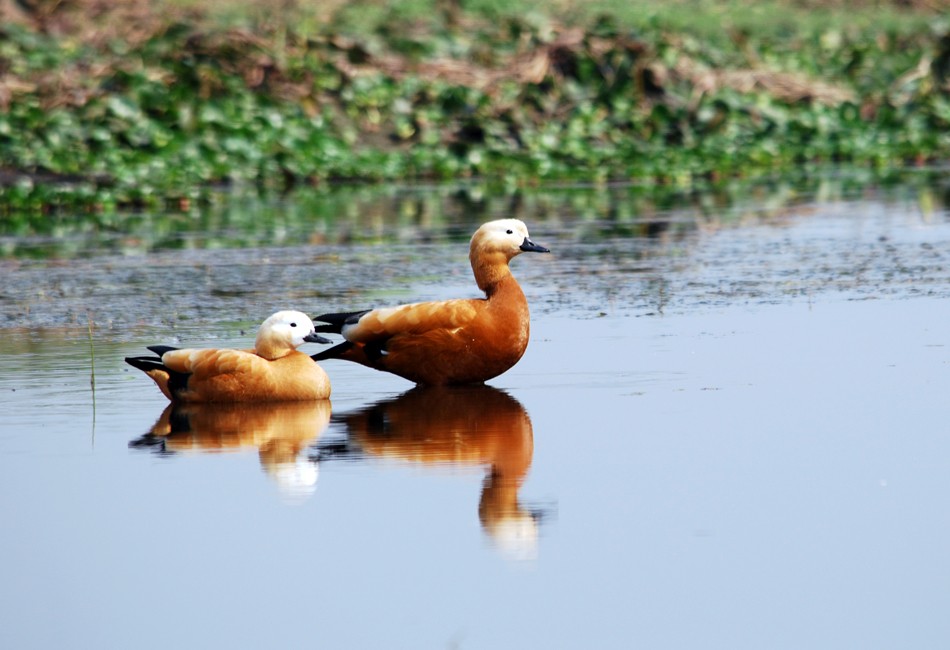Ruddy Shelduck
A species of Typical Shelducks Scientific name : Tadorna ferruginea Genus : Typical Shelducks
Ruddy Shelduck, A species of Typical Shelducks
Botanical name: Tadorna ferruginea
Genus: Typical Shelducks
Content
Description People often ask General Info
 Photo By Jugal Bharali , used under CC-BY-SA-3.0 /Cropped and compressed from original
Photo By Jugal Bharali , used under CC-BY-SA-3.0 /Cropped and compressed from original Description
The ruddy shelduck grows to a length of 58 to 70 cm (23 to 28 in) and has a 110–135 cm (43–53 in) wingspan. The male has orange-brown body plumage and a paler, orange-brown head and neck, separated from the body by a narrow black collar. The rump, flight feathers, tail-coverts and tail feathers are black and there are iridescent green speculum feathers on the inner surfaces of the wings. Both upper and lower wing-coverts are white, this feature being particularly noticeable in flight but hardly visible when the bird is at rest. The bill is black and the legs are dark grey. The female is similar but has a rather pale, whitish head and neck and lacks the black collar, and in both sexes, the colouring is variable and fades as the feathers age. The birds moult at the end of the breeding season and the male loses the black collar, but a further partial moult between December and April restores it. Juveniles are similar to the female but are a darker shade of brown. The call is a series of loud, nasal honking notes, it being possible to discern the difference between those produced by the male and the female. The calls are made both on the ground and in the air, and the sounds are variable according to the circumstances in which they are uttered. 
Size
71 cm
Colors
Brown
Black
Orange
Life Expectancy
8-10 years
Nest Placement
Burrow
Feeding Habits
Ruddy Shelduck has an omnivorous diet, consuming grains, shoots, and tubers. It forages for aquatic plants, insects, crustaceans, molluscs, and small fish, along with frogs and reptilian prey. Its unique adaptations facilitate diverse feeding behaviors, from dabbling to hunting.
Habitat
The ruddy Shelduck typically occupies large inland wetlands, rivers with mud flats, shingle banks, and is abundant around lakes and reservoirs. This bird also resides in inland steppes, deserts, high plateaus, and mountain ranges, preferring freshwater to saline wetlands. Habitats range from sea level to high-altitude environments up to 4,800 meters. Ruddy Shelduck frequents manmade wetlands and avoids coastal waters, with a notable presence in mountain lakes and reservoirs during certain seasons.
Dite type
Omnivorous
People often ask
General Info
Feeding Habits
Bird food type
Behavior
The ruddy shelduck is a mainly nocturnal bird. The ruddy shelduck is usually found in pairs or small groups and rarely forms large flocks. However, moulting and wintering gatherings on chosen lakes or slow rivers can be very large. The birds arrive at their main breeding locations in central Asia in March and April. There is a strong pair bond between the male and female and it is thought they pair for life. 
Distribution Area
There are very small resident populations of this species in north west Africa and Ethiopia, but the main breeding area of the bird is from southeast Europe across the Palearctic to Lake Baikal, Mongolia, and western China. Eastern populations are mostly migratory, wintering in the Indian subcontinent. This species has colonised the island of Fuerteventura in the Canary Islands, first breeding there in 1994, and reaching a population of almost fifty pairs by 2008. The ruddy shelduck is a common winter visitor in India where it arrives by October and departs by April. Its typical breeding habitat is large wetlands and rivers with mud flats and shingle banks, and it is found in large numbers on lakes and reservoirs. It breeds in high altitude lakes and swamps in Jammu and Kashmir. Outside the breeding season it prefers lowland streams, sluggish rivers, ponds, flooded grassland, marshes and brackish lagoons. Although becoming quite rare in southeast Europe and southern Spain, the ruddy shelduck is still common across much of its Asian range. It may be this population which gives rise to vagrants as far west as Iceland, Great Britain and Ireland. However, since the European population is declining, it is likely that most occurrences in western Europe in recent decades are escapes or feral birds. Although this bird is observed in the wild from time to time in eastern North America, no evidence has been found that this is a genuine case of vagrancy. Feral ruddy shelduck have bred successfully in several European countries. In Switzerland the ruddy shelduck is considered an invasive species that threatens to displace native birds. Despite actions taken to reduce numbers, the population of ruddy shelduck in Switzerland increased from 211 to 1250 individuals in the period from 2006 to 2016. This shelduck mostly frequents open locations on inland bodies of water such as lakes, reservoirs and rivers. It is seldom seen in forested areas but does occur in brackish water and saline lagoons. Though more common in the lowlands, it also inhabits higher altitudes and in central Asia is one of the few waterbirds, along with the bar-headed goose (Anser indicus), to be found on lakes at 5,000 m (16,400 ft). 
Species Status
Not globally threatened.
Scientific Classification
Phylum
Chordates Class
Birds Order
Waterfowl Family
Geese Genus
Typical Shelducks Species
Ruddy Shelduck